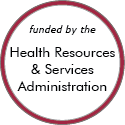Rural Project Examples: Clinics
Effective Examples
Community-Based Pulmonary Rehabilitation Program
Updated/reviewed January 2024
- Need: More evidenced-based chronic lower respiratory disease management options for rural Appalachia patients, where lung disease rates are among the highest in the country.
- Intervention: Implementation of outpatient pulmonary rehabilitation programs in 2 Federally Qualified Health Centers and a Critical Access Hospital in West Virginia.
- Results: Improved health outcomes for patients with chronic lower respiratory disease, including those with chronic obstructive pulmonary disease.
Promising Examples
School-Based Health Center Dental Outreach

Updated/reviewed July 2020
- Need: To improve the oral health status of children ages 3 to 17 living in rural areas of Louisiana.
- Intervention: School-based nurse practitioners perform oral health assessments, apply fluoride varnishes when indicated, and make dental referrals, with completion rates of the latter tracked by dental case managers.
- Results: Significant numbers of school children are receiving oral health examinations, fluoride varnish applications, and receiving care coordination to improve numbers of completed dental appointments.
Other Project Examples
Community Care Partnership of Maine Accountable Care Organization

Updated/reviewed April 2025
- Need: To increase access and quality of care for patients in rural Maine.
- Intervention: Community hospitals and Federally Qualified Health Centers in Maine formed the Community Care Partnership of Maine Accountable Care Organization (CCPM ACO).
- Results: CCPM serves about 120,000 patients in Maine. In addition, it has implemented shared savings arrangements/contracts with different Medicare Advantage and other private health payers.
CMH Addiction Recovery Program

Updated/reviewed November 2024
- Need: To help people who use drugs and their families access treatment and counseling in rural Missouri.
- Intervention: The CMH Addiction Recovery Program provides medication-assisted treatment, counseling, peer and family support, and other related services through a Rural Health Clinic.
- Results: The program operates 5 days a week and sees 400 patients each month.
Mobile Integrated Healthcare Network (MIHN)

Updated/reviewed October 2024
- Need: To bring preventive care and other services to rural Missouri patients with chronic illnesses and difficulties accessing primary care.
- Intervention: Community paramedics and community health workers make home visits and provide basic care, home assessments, and medication reconciliation and facilitate telehealth visits.
- Results: Patients experienced improved access to care, health status, and compliance with medication regimens along with increased patient engagement, satisfaction, and access to community resources.
Scenic Bluffs Community Health Center Help Team

Updated/reviewed October 2024
- Need: To help inform western Wisconsin residents about their health insurance options and local programs to support their healthcare needs.
- Intervention: The Scenic Bluffs Community Health Centers' Help Team offers free services for community members facing barriers to accessing healthcare, such as transportation, language, cost, and insurance, among other social factors.
- Results: In 2023, more than 1,500 people received support and guidance from the Help Team regarding programs, resources, and health insurance enrollment. In total, 466 individuals were enrolled in health insurance.
Georgia Health Initiative's CDFI Investments
Updated/reviewed October 2023
- Need: Across Georgia, especially in rural areas, poor health outcomes and high poverty rates require strategic investments to reduce disparities and improve health across the state.
- Intervention: Georgia Health Initiative invests in Community Development Financial Institutions (CDFIs) working in Georgia to build a strong ecosystem of mission-driven community lenders focused on rural and low-income communities. The capital and capacity building provided by CDFIs support systems change to improve health across the state.
- Results: Since 2017, grants and Program Related Investments (PRIs) in CDFIs working in low-income rural communities have generated impact through stronger and growing Community Health Centers, expanded affordable housing, green energy loans and jobs, and growing small businesses.
FORWARD NM Pathways to Health Careers

Updated/reviewed November 2022
- Need: New Mexico's southwestern counties of Hidalgo, Catron, Luna, and Grant have experienced chronic shortages of primary care providers. New Mexico has the oldest physician population in the country.
- Intervention: A comprehensive workforce pipeline program, including programming for middle and high school students, undergraduate and graduate students, primary care program students, and medical and dental residents.
- Results: The program reaches over 1,000 school-aged students throughout the service areas and provides support for students and medical residents in a variety of healthcare-related programs for rural rotation experiences. FORWARD NM received its designation as an Area Health Education Center (AHEC) in 2012.
Maine Critical Access Integrated Paramedics

Added August 2022
- Need: With the nearest hospital more than an hour away, the local community health center in rural Jackman, Maine struggled to maintain its ability to offer 24/7 care to due to staffing and budgetary challenges.
- Intervention: Critical Access Integrated Paramedics provide urgent care to patients after hours and on weekends.
- Results: The Jackman Community Health Center has been able to offer round-the-clock care to clinic patients, while also increasing the level of EMS service available to the community.
Futures Without Violence in Tillamook County

Updated/reviewed August 2021
- Need: To address intimate partner violence (IPV) in primary care settings as a health concern. To increase healthcare providers' professional understanding about its prevalence and adverse impacts on patient health.
- Intervention: In partnership with Safer Futures, Tides of Change provides an advocate at a local health clinic to give confidential services to IPV survivors and training to medical staff. The advocate uses curriculum and other materials designed by Futures Without Violence.
- Results: Healthcare providers at the clinic reported increased understanding of IPV and its impact on health. As a result, IPV advocates received an increase in referrals from healthcare providers. Patients experiencing IPV reported a reduction in chronic, toxic stress and improved overall health after receiving advocacy services.
For examples from other sources, see:
